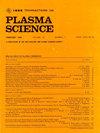基于Fluent模拟方法的阳极结构对层流等离子体射流特性的影响
IF 1.5
4区 物理与天体物理
Q3 PHYSICS, FLUIDS & PLASMAS
引用次数: 0
摘要
建立了基于fluent的仿真模型,研究了圆柱型、拉瓦尔型和收缩型三种典型阳极结构的阳极电流密度分布、内部温度场和速度场。首先,通过分析层流等离子体炬的相关控制方程和理论,建立了基于Fluent的层流等离子体炬的数值模拟模型,并通过实验验证了模型的有效性。然后,利用所建立的模型对等离子炬内部温度场、速度场以及阳极表面电流密度分布进行了模拟和分析。最后,在对模拟结果进行对比分析的基础上,对阳极结构提出了优化建议。结果表明:1)所建仿真模型的仿真结果与实验结果误差小于3%;2)圆柱型阳极电流密度>缩窄型阳极电流密度>拉瓦尔型阳极电流密度;3)三种典型阳极结构对等离子炬内温度场影响不大;但在阳极出口区域,圆柱型阳极结构的出口中心温度最低,径向温度梯度最大;laval型结构的出口中心温度略低于收缩型结构,但其径向温度梯度最小,有利于等离子体流动温度的均匀分散;4)圆柱型结构对应的速度场略低于拉瓦尔型结构和收缩型结构对应的速度场。当采用laval型结构时,阳极区域的速度仅略低于收缩结构。本文章由计算机程序翻译,如有差异,请以英文原文为准。
Effects of Anode Structures on the Laminar Plasma Jet Characteristics Based on Fluent Simulation Method
A Fluent-based simulation model was established to explore the anode current density distribution, as well as the internal temperature and velocity fields with three typical anode structures: cylindrical type, Laval type, and constricted type. First, by analyzing the relevant governing equations and theories of the laminar plasma torch, a numerical simulation model based on Fluent was developed, and its validity was verified through experiments. Then, using the constructed model, the temperature and velocity fields within the plasma torch, along with the anode surface current density distribution, were simulated and analyzed. Finally, based on a comparative analysis of the simulation results, optimization suggestions for the anode structure were proposed. The results indicate that: 1) the error between the simulation results and the experimental results of the constructed simulation model is less than 3%; 2) cylindrical-type anode current density > constricted-type anode current density > Laval-type anode current density; 3) the three typical anode structures have little influence on the temperature field within the plasma torch; however, in the anode outlet area, the outlet center temperature of the cylindrical-type anode structure is the lowest, and the radial temperature gradient is the largest; and the outlet central temperature of the Laval-type structure is slightly lower than that of the constricted-type structure, but its radial temperature gradient is the smallest, which is conducive to the uniform dispersion of the plasma flow temperature; and 4) the velocity field corresponding to the cylindrical-type structure is slightly lower than that corresponding to the Laval-type structure and the constricted-type structure. Moreover, when the Laval-type structure is adopted, the velocity in the anode area is only slightly lower than that of the constricted structure.
求助全文
通过发布文献求助,成功后即可免费获取论文全文。
去求助
来源期刊

IEEE Transactions on Plasma Science
物理-物理:流体与等离子体
CiteScore
3.00
自引率
20.00%
发文量
538
审稿时长
3.8 months
期刊介绍:
The scope covers all aspects of the theory and application of plasma science. It includes the following areas: magnetohydrodynamics; thermionics and plasma diodes; basic plasma phenomena; gaseous electronics; microwave/plasma interaction; electron, ion, and plasma sources; space plasmas; intense electron and ion beams; laser-plasma interactions; plasma diagnostics; plasma chemistry and processing; solid-state plasmas; plasma heating; plasma for controlled fusion research; high energy density plasmas; industrial/commercial applications of plasma physics; plasma waves and instabilities; and high power microwave and submillimeter wave generation.
 求助内容:
求助内容: 应助结果提醒方式:
应助结果提醒方式:


